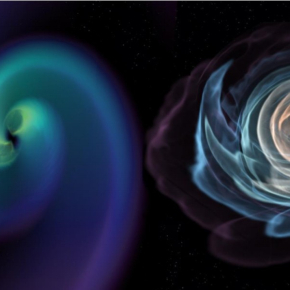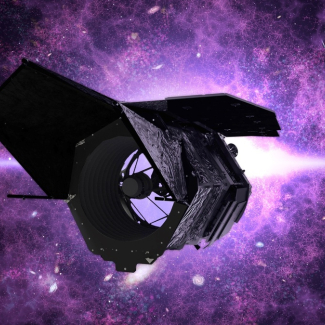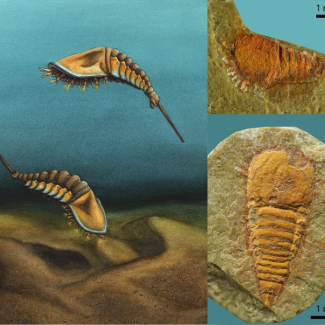
Gravitational waves shed first light on mergers of neutron stars
This is a major breakthrough in more than one respect. The scientists of the LIGO-Virgo Collaboration (which includes the CNRS) have for the first time observed the gravitational waves emitted by the merger of two neutron stars, rather than of two black holes as in previous cases. In another first, the light emitted from the source of gravitational waves was observed in the following hours, days and weeks, by 70 other ground- and space-based observatories. This series of observations marks the birth of multi-messenger1 astronomy, and has produced a wealth of results, including a solution to the mystery of gamma-ray bursts and that of the origin of the heaviest elements (such as lead, gold and platinum), as well as new insights into the properties of neutron stars, and an independent measurement of the rate of expansion of the Universe. These various findings are described in a dozen scientific articles published on 16 October 2017 by a number of researchers from CNRS laboratories (more than 200 for one of the publications), members of the LIGO-Virgo Collaboration, and partner astronomy groups.
- 1Gravitational waves are 'messengers' from the cosmos that complement traditional astronomical observations based on the entire electromagnetic spectrum (visible light, UV, infrared, radio waves, X-rays and gamma rays), on cosmic rays and on neutrinos.
An unprecedented series of events began at 12:41 (UTC) on 17 August 2017 with the detection of a new type of gravitational wave signal. This time, the signal detected was considerably longer than in the case of black hole mergers (around a hundred seconds as opposed to a fraction of a second), a sign that the two objects that finally coalesced were different from those previously detected. Detailed analysis of the data showed that the masses of the two objects lay somewhere between 1.1 and 1.6 times the mass of the Sun, corresponding to the mass of neutron stars.
Neutron stars are the remains of massive stars. At the end of its life, a giant star explodes, giving rise to a supernova. This extremely luminous phenomenon only lasts from a few days to several weeks: once it is over, all that remains is a very dense core made up almost entirely of neutrons—a neutron star. Although only about the size of a city like London, a teaspoon of the material making it up would weigh around a billion tons: neutron stars are the smallest and densest stars discovered so far. Just like the ordinary stars from which they derive, some of them form pairs, orbiting around each other and gradually getting closer while losing energy in the form of gravitational waves—a process that finally accelerates until they merge. While this scenario was predicted by models, this is the first time it has been confirmed by observation.
Almost simultaneously and independently, NASA's Fermi satellite recorded a gamma-ray burst—a very high-energy flash of electromagnetic radiation—and immediately sent out an automatic alert. Although this type of burst is relatively common (about once a week on average), this one was special in that it was detected around two seconds after the end of the gravitational wave signal, indicating that the two events were closely connected. In addition, analysis of the data from Fermi showed that it lay within a region of the sky covering 1 100 square degrees, which was compatible with the localization recorded by the Virgo and LIGO detectors. The gamma-ray burst was also detected by the European Space Agency (ESA) INTEGRAL satellite. These observations confirmed that at least some short gamma-ray bursts are caused by neutron star mergers.
A new astronomy has dawned
At the same time, the source was localized in the sky by using the arrival times and amplitude of the signals measured by the three gravitational wave detectors (the two LIGO detectors in the US and the Virgo detector in Europe). The area thus determined, which covered about 30 square degrees2
in the Hydra constellation in the southern hemisphere, was tens of times smaller than that determined by Fermi. It was communicated to around 90 partner astronomy groups so that they could point their instruments in that direction. Twelve hours later, the 1M2H group using the American Swope telescope in Chile announced they had discovered a new bright point of light in the NGC4993 galaxy, located 130 million light-years from Earth. This finding was rapidly confirmed by other telescopes operating independently3
. A number of instruments then carried out observations, including the ESO's telescope in Chile and the Hubble Space Telescope.
The region was then continuously scanned, and initial analyses of light spectra4
showed that this was not a supernova but a type of object that had never been seen before, made up of very hot matter in the process of cooling, with rapidly decreasing luminosity—leading to a race against time to observe it before it faded away altogether.
According to models, nuclear reactions take place in the matter ejected by the merger of two neutron stars, causing the formation of atomic nuclei heavier than iron (such as gold, lead, etc), due to the abundance of neutrons. This very hot, radioactive matter then disperses, emitting light at every wavelength. Initially very blue, this light becomes redder as the matter cools and disperses. Known as a kilonova, this phenomenon, hitherto merely predicted by theory, has now been convincingly confirmed. What is probably the principal process that forms the Universe's heaviest elements has therefore now been observed for the first time.
As well as confirming that mergers of neutron stars produce short gamma-ray bursts, providing the first unambiguous detection of a kilonova and showing that the Universe's heavy elements are formed in this process, this series of observations also provides a better understanding of the physics of neutron stars and makes it possible to rule out certain extreme theoretical models. It also provides a new way of measuring the Hubble constant, which describes the rate of expansion of the Universe. These results, which involve various disciplines (nuclear physics, astrophysics, cosmology, gravitation), illustrate the potential of a newly-emerging astronomy, based on several types of cosmic messenger (gravitational waves, electromagnetic radiation such as light and gamma rays, and perhaps one day particles such as neutrinos and cosmic rays). They are described in a dozen papers, one of which is the work of several thousand researchers gathered together in around fifty collaborations.
The LIGO-Virgo collaboration
The Virgo interferometer was built near Pisa about 25 years ago by the French National Center for Scientific Research (CNRS) and the Italian Istituto Nazionale di Fisica Nucleare(INFN). The Virgo collaboration consists of more than 280 physicists and engineers belonging to 20 different European research groups: six from the CNRS in France; eight from the INFN in Italy; two in the Netherlands with Nikhef; the MTA Wigner RCP in Hungary; the POLGRAW group in Poland; Spain with the University of Valencia; and the European Gravitational Observatory, EGO, the laboratory hosting the Virgo detector near Pisa in Italy, funded by CNRS, INFN, and Nikhef.
LIGO is funded by the NSF, and operated by Caltech and MIT, which conceived of LIGO and led the Initial and Advanced LIGO projects. Financial support for the Advanced LIGO project was led by the NSF with Germany (Max Planck Society), the U.K. (Science and Technology Facilities Council) and Australia (Australian Research Council) making significant commitments and contributions to the project. More than 1,200 scientists from around the world participate in the effort through the LIGO Scientific Collaboration, which includes the GEO Collaboration. Additional partners are listed at http://ligo.org/partners.php.
The scientific publications of the LIGO and Virgo collaborations announcing the discovery are co-authored by 76 scientists from six teams from CNRS and associated universities:
- Laboratoire AstroParticule et Cosmologie (Université Paris Diderot/CNRS/CEA/Observatoire de Paris), Paris;
- Laboratoire Astrophysique Relativiste, Théories, Expériences, Métrologie, Instrumentation, Signaux (CNRS/Observatoire de la Côte d'Azur/Université Nice Sophia Antipolis), Nice;
- Laboratoire de l'Accélérateur Linéaire (CNRS/Université Paris-Sud), Orsay;
- Laboratoire d'Annecy de Physique des Particules (CNRS/Université Savoie Mont Blanc), Annecy;
- Laboratoire Kastler Brossel (CNRS/UPMC/ENS/Collège de France), Paris;
- Laboratoire des Matériaux Avancés (CNRS), Villeurbanne.
French researchers also involved in the detection of electromagnetic signals
In addition to the researchers in the Virgo Collaboration, about 160 French scientists are part of the Antares, DECam, DLT40, ePESSTO, Fermi, GRAWITA, HESS, INTEGRAL, OzGrav, Pierre Auger and TZAC collaborations that co-authored the publication summarizing the series of observations. Some of them are also involved in more specific publications unveiled today.
These researchers belong to the following laboratories:
- Astroparticule et cosmologie laboratory (CNRS/CEA/Observatoire de Paris/Université Paris Diderot)
- Astrophysique relativiste, théories, expériences, métrologie, instrumentation, signaux laboratory (CNRS/Observatoire de la Côte d'Azur/Université de Nice Sophia Antipolis)
- Astrophysique, instrumentation, modélisation laboratory (CNRS/CEA/Université Paris Diderot)
- Centre d'études nucléaires de Bordeaux Gradignan (CNRS/Université de Bordeaux)
- Centre de physique des particules de Marseille (CNRS/Aix-Marseille Université)
- Galaxies, étoiles, physique, instrumentation laboratory (CNRS/Observatoire de Paris/Université Paris Diderot)
- Géoazur laboratory (CNRS/Observatoire de la Côte d'Azur/Université de Nice Sophia Antipolis)
- Groupe de recherche en physique des hautes énergies (Université de Haute-Alsace)
- Institut d'astrophysique de Paris (CNRS/UPMC)
- Institut de physique nucléaire d'Orsay (CNRS/Université Paris-Sud)
- Institut de planétologie et d'astrophysique de Grenoble (CNRS/Université de Grenoble Alpes)
- Institut de recherche en astrophysique et planétologie (CNRS/CNES/Université Toulouse III – Paul Sabatier)
- Institut de recherche sur les lois fondamentales de l'Univers (CEA)
- Institut méditerranéen d'océanographie (CNRS/IRD/Aix-Marseille université/Université de Toulon)
- Institut pluridisciplinaire Hubert Curien (CNRS/Université de Strasbourg)
- Laboratoire d'Annecy de physique des particules (CNRS/Université de Savoie Mont-Blanc)
- Laboratoire d'astrophysique de Marseille (CNRS/Aix-Marseille Université)
- Laboratoire de physique de Clermont (CNRS/Université Clermont Auvergne)
- Laboratoire de physique corpusculaire de Caen (CNRS/Ensicaen/Université de Caen)
- Laboratoire de physique et chimie de l'environnement et de l'espace (CNRS/Université d'Orléans)
- Laboratoire de physique nucléaire et des hautes énergies (CNRS/Université Paris Diderot/UPMC)
- Laboratoire de physique subatomique et cosmologie (CNRS/Grenoble INP/Université Grenoble Alpes)
- Laboratoire de physique subatomique et des technologies associées (CNRS/IMT Atlantique/Université de Nantes)
- Laboratoire des sciences de l'information et des systèmes (CNRS/Aix-Marseille université/Université de Toulon)
- Laboratoire Leprince-Ringuet (CNRS/École polytechnique)
- Laboratoire Univers et particules de Montpellier (CNRS/Université de Montpellier)
- Laboratoire Univers et théories (CNRS/Observatoire de Paris/Université Paris Diderot)
- Station de radioastronomie de Nançay (CNRS/Observatoire de Paris/Université d'Orléans)
CNRS Facebook Live
On Monday October 16 at 7 PM CEST (Central European Summer Time), the CNRS will broadcast live from the Advanced Virgo gravitational wave detector in Italy. From the control room, researchers will answer questions and showcase the instrument (English only).
Direct access to the CNRSNews Facebook page: https://www.facebook.com/CNRSNews/
For more information:
CNRS News article: https://news.cnrs.fr/node/1197
Images are available on : http://phototheque.cnrs.fr/p/271-1-1-0/
GW170817: Observation of gravitational waves from a binary neutron star inspiral, The LIGO Scientific Collaboration & The Virgo Collaboration. Physical Review Letters, 16 octobre 2017.
DOI:10.1103/PhysRevLett.119.161101
Multi-messenger Observations of a Binary Neutron Star Merger, The LIGO Scientific Collaboration & The Virgo Collaboration avec une cinquantaine d'autres collaborations. The Astrophysical Journal Letters, in press (2017). DOI:10.3847/2041-8213/aa91c9
Gravitational Waves and Gamma Rays from a Binary Neutron Star Merger: GW170817 and GRB 170817A, The LIGO Scientific Collaboration & The Virgo Collaboration avec les collaborations Fermi et INTEGRAL. The Astrophysical Journal Letters, in press (2017). DOI:10.3847/2041-8213/aa920c
A standard siren measurement of the Hubble constant with GW170817, The LIGO Scientific Collaboration & The Virgo Collaboration, The 1M2H Collaboration, The Dark Energy Camera GW-EM Collaboration & the DES Collaboration, The DLT40 Collaboration, The Las Cumbres Observatory Collaboration, The VINROUGE Collaboration & The MASTER Collaboration.Nature, 16 octobre 2017. DOI: 10.1038/nature24471
Spectroscopic identification of r-process nucleosynthesis in a double neutron star merger, E. Pian, P. D'Avanzo, S. Benetti, M. Branchesi, E. Brocato, S. Campana, E. Cappellaro, S. Covino, V. D'Elia, J. P. U. Fynbo, F. Getman, G. Ghirlanda, G. Ghisellini, A. Grado, G. Greco, J. Hjorth, C. Kouveliotou, A. Levan, L. Limatola, D. Malesani, P. A. Mazzali, A. Melandri, P. Møller, L. Nicastro, E. Palazzi, S. Piranomonte, A. Rossi, O. S. Salafia, J. Selsing, G. Stratta, M. Tanaka, N. R. Tanvir, L. Tomasella, D. Watson, S. Yang, L. Amati, L. A. Antonelli, S. Ascenzi, M. G. Bernardini, M. Boër, F. Bufano, A. Bulgarelli, M. Capaccioli, P. G. Casella, A. J. Castro-Tirado, E. Chassande-Mottin, R. Ciolfi, C. M. Copperwheat, M. Dadina, G. De Cesare, A. Di Paola, Y. Z. Fan, B. Gendre, G. Giuffrida, A. Giunta, L. K. Hunt, G. Israel, Z.-P. Jin, M. Kasliwal, S. Klose, M. Lisi, F. Longo, E. Maiorano, M. Mapelli, N. Masetti, L. Nava, B. Patricelli, D. Perley, A. Pescalli, T. Piran, A. Possenti, L. Pulone, M. Razzano, R. Salvaterra, P. Schipani, M. Spera, A. Stamerra, L. Stella, G. Tagliaferri, V. Testa, E. Troja, M. Turatto, S. D. Vergani, D. Vergani. Nature, 16 octobre 2017. DOI: 10.1038/nature24298
More than 50 scientific publications are being prepared following these observations.
In an effort to promote open science, the LIGO-Virgo Collaboration publishes data related to this discovery on: View web site


